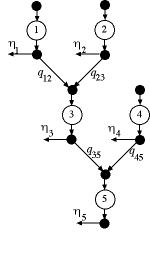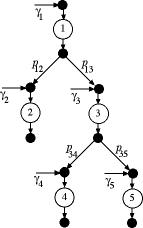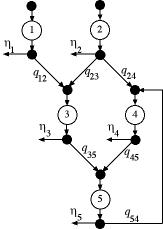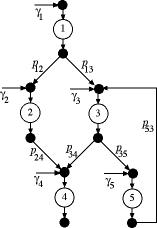|
|
 |
Process
Flow Analysis |
 |
- Drive/Structure
In this section we recognize two structure alternatives, tree
and network, and two drive alternatives, pull and push. To find
the flows in the operations of a process, the structure of the
process and the driver of the flows must be specified. We review
the four possibilities on this page. More detailed pages are
reached through the links on the titles.
|
|
The structure and drive
options are set with buttons on the Add Process dialog.
The structure determines the arrangement of the flow paths in
the operations chart. A tree either starts with a single raw
material and the flow diverges to produce multiple products,
or starts with several raw materials and the flow converges
to produce a single product. A network allows an arbitrary interconnection
between operations.
The drive option specifies the cause of flow through the process.
For the pull option, products are pulled from the outputs of
operations. For the push option, items are pushed into the inputs
of the operations. |


Figure 1
|
The generic pull/tree process is illustrated in Figure 1. For
this structure the flow through each operation goes to a unique
following operation, while each operation may have several input
flows from other operations. This structure is appropriate for
modeling many manufacturing processes where raw materials are
combined or mixed to produce a single product. Product is withdrawn
or pulled from the operation with the greatest index, operation
5 for the example, in the amount  .
For analysis purposes we will usually assume that this amount
is 1, so we can compute the flow through each operation per
unit of finished good.
In addition to the final operation of the process, our models
also allow flow to be pulled from the other operations. These
flows represent intermediate products. In general, we identify
the amount pulled from the output of operation i as
 ,
the pull flow at operation i. ,
the pull flow at operation i.
For the tree structures we require that the operations be indexed
so that when flow passes from operation i to operation
j, i < j. The greatest index is
m. For the example m is 5.
For the pull tree, we identify  as the amount of the output of operation i required
for each unit of product passing through operation j.
The value of
as the amount of the output of operation i required
for each unit of product passing through operation j.
The value of  may be any positive amount to represent a variety of manufacturing
situations. An assembly operation that requires one unit of
each input to be combined to produce one unit of a subassembly
would have the proportions equal to 1 for each input. A mixing
operation that combines inputs into a mixture would have input
proportions that sum to 1. An operation that requires more than
one unit of some input would be modeled with a proportion greater
than 1 on the associated input.
may be any positive amount to represent a variety of manufacturing
situations. An assembly operation that requires one unit of
each input to be combined to produce one unit of a subassembly
would have the proportions equal to 1 for each input. A mixing
operation that combines inputs into a mixture would have input
proportions that sum to 1. An operation that requires more than
one unit of some input would be modeled with a proportion greater
than 1 on the associated input. |
|

Figure 2 |
The generic push/tree
process is illustrated in Fig. 2. For this structure the flow
into an operation comes from a unique preceding operation, while
the operation may have several output flows going to other operations.
This structure is appropriate for modeling service systems where
customers arrive at a source node, node 1 in the example in
the amount  .
We call the items entering the system, units of product. In
addition to node 1, products may also be pushed into the network
at other operations. The flow entering at operation i
is .
We call the items entering the system, units of product. In
addition to node 1, products may also be pushed into the network
at other operations. The flow entering at operation i
is  .
Note that push flow enters the process just before an operation. .
Note that push flow enters the process just before an operation.
The flow that passes through an operation may be split to go
to other operations to receive different types of processing.
Units pass through the tree until finally they are withdrawn
at the nodes that have no successors, nodes 2, 4 and 5 in the
figure. For analysis purposes, we will usually assume that  = 1 and that all other
= 1 and that all other  are zero, so that we can compute the flows passing through the
operations per unit of flow entering node 1. We call these amounts
the unit flows.
are zero, so that we can compute the flows passing through the
operations per unit of flow entering node 1. We call these amounts
the unit flows.
For the tree structures we require that the operations be numbered
so that when flow passes from operation i to operation
j, i < j. The greatest index is
m. For the push tree, we identify  as the proportion of the output of operation i that
is passed to operation j. The value of
as the proportion of the output of operation i that
is passed to operation j. The value of  may be any positive amount to represent a variety of manufacturing
situations. For a splitting operation that separates the total
flow passing through operation i into several paths,
the sum of the proportions leaving i would equal 1.
may be any positive amount to represent a variety of manufacturing
situations. For a splitting operation that separates the total
flow passing through operation i into several paths,
the sum of the proportions leaving i would equal 1. |
| Pull/Network
Process

Figure 3 |
The pull/network process is illustrated in Fig. 3. For this structure
the flow through each operation may go to more than one operation,
and each operation may have several input flows from other operations.
This is a more general structure than the pull/tree structure.
Product is withdrawn or pulled from any of the operations. Again
we use  as the amount pulled from operation i. With m
operations we assign the value of 1 to
as the amount pulled from operation i. With m
operations we assign the value of 1 to  .
The pull flows from the other operations are given as relative
to .
The pull flows from the other operations are given as relative
to  .
Indices are assigned to the operations arbitrarily, however, it
is often convenient to assign the indices to be increasing in
the direction of primary product flow. .
Indices are assigned to the operations arbitrarily, however, it
is often convenient to assign the indices to be increasing in
the direction of primary product flow.
For the pull network, we identify  as the amount of the output of operation i required
for each unit of product passing through operation j.
The value of
as the amount of the output of operation i required
for each unit of product passing through operation j.
The value of  may be any nonnegative amount to represent a variety of manufacturing
situations. An assembly operation that requires one unit of
each input to be combined to produce one unit of a subassembly
would have the proportions equal to 1 for each input. A mixing
operation that combines inputs into a mixture would have input
proportions that sum to 1. An operation that requires more than
one unit of some input would be modeled with a proportion greater
than 1 on the associated input.
may be any nonnegative amount to represent a variety of manufacturing
situations. An assembly operation that requires one unit of
each input to be combined to produce one unit of a subassembly
would have the proportions equal to 1 for each input. A mixing
operation that combines inputs into a mixture would have input
proportions that sum to 1. An operation that requires more than
one unit of some input would be modeled with a proportion greater
than 1 on the associated input.
The example shows an arc passing from operation 5 back to operation
4. In a practical instance, this might represent the reworking
of some part. Although we might be tempted to identify  as the proportion of the output of operation 5 returned to operation
4, this is not correct for a pull network.
as the proportion of the output of operation 5 returned to operation
4, this is not correct for a pull network.  is the proportion of the flow through operation 4 that comes
from operation 5. Similarly,
is the proportion of the flow through operation 4 that comes
from operation 5. Similarly,  is
the proportion of the flow through operation 4 that comes from
operation 2. is
the proportion of the flow through operation 4 that comes from
operation 2. |
| Push/Network
Process

Figure 4 |
The push/network process is illustrated in Fig. 4. For this structure
the flow through each operation may go to more than one operation,
and each operation may have several input flows from other operations.
This is a more general structure than the push/tree process. Product
is inserted or pushed into any of the operations. We use  as the amount pushed into operation i. We assign the
value of 1 to
as the amount pushed into operation i. We assign the
value of 1 to  .
The push flows to the other operations are given as relative to .
The push flows to the other operations are given as relative to
 .
Indices are assigned to the operations arbitrarily, however, it
is often convenient to assign the indices to be increasing in
the direction of primary product flow. .
Indices are assigned to the operations arbitrarily, however, it
is often convenient to assign the indices to be increasing in
the direction of primary product flow.
For the push network we identify  as the amount of the output of operation i that is
passed to operation j for each unit of product passing
through operation i. The value of
as the amount of the output of operation i that is
passed to operation j for each unit of product passing
through operation i. The value of  may be any nonnegative amount. Typically for a service system,
the sum of the proportions leaving an operation is equal to
1. This means that the flow is split among the several following
operations. It may be necessary to use other combinations of
proportions to represent different systems.
may be any nonnegative amount. Typically for a service system,
the sum of the proportions leaving an operation is equal to
1. This means that the flow is split among the several following
operations. It may be necessary to use other combinations of
proportions to represent different systems.
The example shows an arc passing from operation 5 back to operation
3. The value of  is the proportion of the output of operation 5 returned to operation
3. In a practical instance, this might represent the reworking
of some part. It is not necessary to define a proportion for
the flow leaving the system at operation 5.
is the proportion of the output of operation 5 returned to operation
3. In a practical instance, this might represent the reworking
of some part. It is not necessary to define a proportion for
the flow leaving the system at operation 5. |
|
|



